
ENGR.ECONOMIC ANALYSIS
14th Edition
ISBN: 9780190931919
Author: NEWNAN
Publisher: Oxford University Press
expand_more
expand_more
format_list_bulleted
Concept explainers
Question
A6

Transcribed Image Text:In any given week, Anne receives satisfaction only from the consumption of goods and from the consumption of leisure L, which is measured in hours. Obviously, Anne consumes many
different types of goods, but for simplicity we aggregate the dollar value of all the goods that she consumes during the week and call it C. Assume that if Anne chooses to work, the hourly
wage rate is w = 8 and she has to sleep 8 hours per day. (Sleeping time is not considered leisure.) Potentially, if she wants, she can work up to 7 days a week.
If Anne chooses to devote 0 hours to leisure during the week, how much can she consume? C =
If Anne chooses to devote all available hours (except those she has to sleep) to leisure during the week, how much can she consume? C =
If Anne chooses to devote 27 hours to leisure during the week, how much can she consume? C =
Suppose w = 5 and the government gives Anne a subsidy of $300. She receives this money unconditionally, regardless of how many hours she works. We define Anne's budget set over
bundles of C and L, i.e. (C,L). Placing C on the horizontal axis and L on the vertical axis, depict Anne's budget set. The outer boundary of Anne's budget set has a kink at (C,L)=(300, (fill in the
blank)
Suppose w = 5 and the government gives Anne a subsidy such that her consumption is at least $300. That is, if she does not work at all, the government gives her $300. If she works enough to
earn some d dollars towards consumption, the government gives her $300 - d. If she works enough to earn d > 300, the government does not give her anything. We define Anne's budget set
over bundles of C and L, i.e. (C,L). Placing C on the horizontal axis and L on the vertical axis, depict Anne's budget set. The outer boundary of Anne's budget set has two kinks. One kink - the one
with the higher L of the two - is at (C,L)=(300) (fill in the blank)
... while the other kink - the one with the lower L of the two is at is at (C,L)=(300,) (fill in the blank)....
Expert Solution
This question has been solved!
Explore an expertly crafted, step-by-step solution for a thorough understanding of key concepts.
This is a popular solution
Trending nowThis is a popular solution!
Step by stepSolved in 4 steps

Knowledge Booster
Learn more about
Need a deep-dive on the concept behind this application? Look no further. Learn more about this topic, economics and related others by exploring similar questions and additional content below.Similar questions
- Question 1 Use the numbers below for questions #1-3. Filing Status: Single Total Income: $73, 883 Income Adjustments: $0 Itemized Deductions: $14,239 What is the Adjusted Gross Income for this individual?arrow_forward13) Property that is titled as “joint tenants” allows for: a. the property to pass outside of the probate process to a surviving joint ownerr b. tenants to remain in a leased property if the lessor dies. c. the decedent’s interest in the property to avoid inclusion in his or her estate for estate tax purposes. d. a distribution to the joint survivor that is recognized as taxable income.arrow_forward3. ood and most ancilsumammoss ewans oy bouo Seszneuxa anauort at bofovab ed. asa emooni viridnomjorts Carissa wishes to borrow $280,000. Lender A qualifies her for a rate of 4.59% Lender B will give her 3.29% for a 20-year loan. Excluding taxes, amount of the loan payment for each. Round goizuol ont of animosaA to our worl 000 822 over a 30-year and term, all other charges, find the insurance and your answer to the nearest whole dollar.arrow_forward
- When a business sells good to A. Both on credits debtor is debted and is creditedarrow_forwardQuestion 25 Subtraction of from Gross National Product yields Gross Domestic Product. O factor income to the rest of the world F Onet factor income O depreciation Onet government income Onone of the above A Click Submit to complete this assessment. Type here to search IF Q A 12. S 13 # D $ Et V R % 1 Chiparrow_forwardPLS HELP ASAP ON BOTHarrow_forward
arrow_back_ios
arrow_forward_ios
Recommended textbooks for you

 Principles of Economics (12th Edition)EconomicsISBN:9780134078779Author:Karl E. Case, Ray C. Fair, Sharon E. OsterPublisher:PEARSON
Principles of Economics (12th Edition)EconomicsISBN:9780134078779Author:Karl E. Case, Ray C. Fair, Sharon E. OsterPublisher:PEARSON Engineering Economy (17th Edition)EconomicsISBN:9780134870069Author:William G. Sullivan, Elin M. Wicks, C. Patrick KoellingPublisher:PEARSON
Engineering Economy (17th Edition)EconomicsISBN:9780134870069Author:William G. Sullivan, Elin M. Wicks, C. Patrick KoellingPublisher:PEARSON Principles of Economics (MindTap Course List)EconomicsISBN:9781305585126Author:N. Gregory MankiwPublisher:Cengage Learning
Principles of Economics (MindTap Course List)EconomicsISBN:9781305585126Author:N. Gregory MankiwPublisher:Cengage Learning Managerial Economics: A Problem Solving ApproachEconomicsISBN:9781337106665Author:Luke M. Froeb, Brian T. McCann, Michael R. Ward, Mike ShorPublisher:Cengage Learning
Managerial Economics: A Problem Solving ApproachEconomicsISBN:9781337106665Author:Luke M. Froeb, Brian T. McCann, Michael R. Ward, Mike ShorPublisher:Cengage Learning Managerial Economics & Business Strategy (Mcgraw-...EconomicsISBN:9781259290619Author:Michael Baye, Jeff PrincePublisher:McGraw-Hill Education
Managerial Economics & Business Strategy (Mcgraw-...EconomicsISBN:9781259290619Author:Michael Baye, Jeff PrincePublisher:McGraw-Hill Education


Principles of Economics (12th Edition)
Economics
ISBN:9780134078779
Author:Karl E. Case, Ray C. Fair, Sharon E. Oster
Publisher:PEARSON

Engineering Economy (17th Edition)
Economics
ISBN:9780134870069
Author:William G. Sullivan, Elin M. Wicks, C. Patrick Koelling
Publisher:PEARSON

Principles of Economics (MindTap Course List)
Economics
ISBN:9781305585126
Author:N. Gregory Mankiw
Publisher:Cengage Learning

Managerial Economics: A Problem Solving Approach
Economics
ISBN:9781337106665
Author:Luke M. Froeb, Brian T. McCann, Michael R. Ward, Mike Shor
Publisher:Cengage Learning

Managerial Economics & Business Strategy (Mcgraw-...
Economics
ISBN:9781259290619
Author:Michael Baye, Jeff Prince
Publisher:McGraw-Hill Education